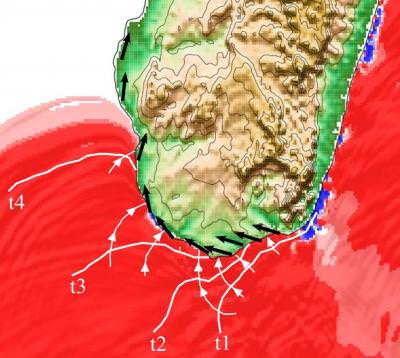[/caption] Coastal formations called chevrons, large U- or V-shaped features found on coastlines around the world were originally thought to be evidence of ancient "megatsunamis" caused by asteroids or comets slamming into the ocean. However, new research using Google Earth and computer models to recreate large wave action refutes that school of thought.
The theory of chevrons being created by tsunamis was
proposed in 2006
after the structures were found in Egypt and the Bahamas. Some were, at places, between several hundred meters- and a kilometer-wide. Since they were also found to exist in Australia and Madagascar, some geologists formed the hypothesis that they were sediment cones left behind by large tsunamis, perhaps up to ten times stronger than the devastating tsunami in the Indian Ocean in December 2005.
The theory propsed the only source for such a megatsunami was a meteor impact, occurring about 5,000 years ago.
But a new study, led by Jody Bourgeois, a geologist and tsunami expert at the University of Washington, argues that this theory is simply "nonsense. For example, she said, there are numerous chevrons on Madagascar, but many are parallel to the coastline. Models created by Bourgeois' colleague Robert Weiss show that if they were created by tsunamis they should point in the direction the waves were travelling, mostly perpendicular to the shore. [caption id="attachment_30230" align="aligncenter" width="560" caption="Landsat image of the Fenambosy Chevrons in Madagascar by USGS. The open side of these chevrons point directly at a crater at the bottom of the Indian Ocean. They suggest a gigantic meteor impact occurred about 4800 years ago. But new research says chevrons were likely formed by wind."]
[/caption] "And if it really was from an impact, you should find evidence on the coast of Africa too, since it is so near," she said.
By using Google Earth, Bourgeois and her team searched for chevrons and surprisingly they found some in desert areas, well inland and away from the shores.
"The extraordinary claim of 'chevron' genesis by megatsunamis cannot withstand simple but rigorous testing. There are the same forms in the Palouse in eastern Washington state, and those are clearly not from a tsunami," Bourgeois said.
She believes the structures were formed by wind.
The discovery of marine fossils in some chevron formations seems to support the idea that a wave created the deposit, but Bourgeois discounts that evidence also.
"Marine fossils can get into non-marine deposits. It's not uncommon. You only have to change sea level a little bit or have them wash up on a beach in a storm," she said. "And some marine organisms can be carried by the wind. I am convinced these are largely wind-blown deposits."
She noted that similar deposits have been seen on the Kamchatka Peninsula on Russia's east coast, where she has conducted research for more than a decade.
"Those are made of volcanic ash, and they are not near the coast at all, yet they look very similar to these coastal chevrons," Bourgeois said.
Source: Newswise
 Universe Today
Universe Today
